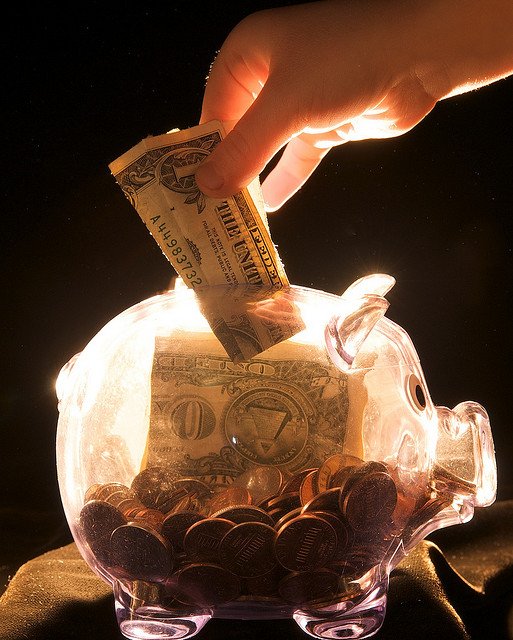A month? Perhaps I’m brain-washed from living in this money-blog community of mine, but doesn’t everyone know by now that you’re supposed to have 3 to 6 months worth of emergency money stashed up at all times? Disaster could strike at any time whether you’re ready for it or not! And if you’re not prepared well in advance to handle such a situation, you’ll find yourself in a whole lot of trouble.
Why Don’t We Do A Better Job Saving for Emergencies?
Why do most people struggle to put together an emergency fund? Is it because preparing for the unknown or uncertain is so intangible.
Perhaps that’s true. If you really take a step back from the whole thing, you’ll notice that this isn’t just a problem that’s limited to money we can quickly access in times of crisis. As a nation we’re pretty deficient in a lot of other major savings categories such retirement or funding of specific goals (like the down payment of a house or car). As a matter of fact the average savings rate for Americans rose only to 5.5% in 2015. Unfortunately if that number represents both life savings (for the future) and warding off present danger, then your financial firewall is toast!
Make Your Emergency Fund Beyond Average:
Though that stat may be an average trend, I never want you to settle for average when it comes to money. There are lots of ways to build up your financial hedge without feeling like you’re losing a limb.
#1 Automation:
It took me years to do this, but it worked really well. All you need to do is open up an online savings account with someone good like Ally. Then slowly transfer money out of your regular checking or savings account every month.That’s it! Just a few bucks ($50 or $100 or so) will do. It will be so trivial that you’ll never even notice its gone; like a bill that you regularly pay so often that you forget all about it.
I used this technique for years until I built up quite a sizable cushion of my own. Then I also starting combining it with this one …
#2 Large Windfalls:
Are you getting a nice tax refund this year? What about a bonus you received back at Christmas time? Whenever we receive a sizable check, it’s always a good time to ask ourselves: What do I intend to do with this? If you can’t come up with anything good, then squirreling it away in your emergency fund is a great place to park it.
This past year when I received my annual bonus, I made sure to devote a portion of it for our disaster fund. Though it was mentally tough (because there were about a thousand other things I would have rather spent the money on), I knew it was the right decision.
#3 Open a Roth IRA Account:
Though I’d normally recommend that you keep these two things separate, I also understand that coming up with savings can be tight. If that’s truly the case, then why not get the best of both worlds and use a Roth IRA to build your emergency fund.
Though it would actually be money that’s earmarked for retirement, the nice thing about a Roth IRA is that you can withdraw your principal investment at any time (because you’ve already paid taxes on this amount). So if there ever was a “true” emergency, you’ve got that as an option. (Though I’d highly advise you to be critical about making any sort of withdrawal because it will affect your future earnings growth potential.)
The upside to this is that you get all the awesome tax-free benefits of compounding earnings! Your stash gets to be invested in assets that will grow with the market and flourish so long as you don’t dip into them. Again someone like Ally would be very useful in helping you get started on this path.
No matter how you decide to go about it, the takeaway from all this is to do something, even having knowledge of current home equity loan rates to use the equity in your home as an emergency fund can come in handy. Don’t be the only one driving a car without an airbag. Give yourself and your loved ones the kind of financial security you deserve and start building up your emergency money fund right away. Though it will definitely take some time and discipline to pull it all together, it will all be worth it when you’re ready and prepared.
Readers – How did you build up your emergency fund? What was your target savings goal?
Image courtesy of Ken Wilcox | Flickr



Agreed, it’s very important to have a bigger emergency fund so you’re well prepared for anything that arises. It just gives you that peace of mind, at least with the financial aspect. It should be one of the first things you put your money in. I’m glad you mentioned the Roth IRA (and the reminder!) because it’s a viable option for a lot of people.
Although it really should be sanctioned for retirement, the Roth IRA isn’t a bad choice for people who can’t divide up their savings efforts. I do think at a minimum most people need to just concentrate on building up a month or better of liquid savings.
Great advice! Any of the online banks will do as a place to build up funds. Ally, CIT Bank, Capital One 360, etc. Might I also recommend short term CD’s (3 month terms) that renew automatically and only forfeit your interest if you break them? This way, you have access to your money and at a higher rate than a savings account. Sure you will lose 3 months interest if you break the CD, but the interest rate is only a slight hedge against inflation and not an investment. As long as the money is fully liquid and can be withdrawn or transferred on the spot, then that is what you need.
Good call. Short term CD’s can be just as effective as online savings accounts; if not more helpful because you’ll probably think twice about whether or not you’ve got a true emergency and need to “break the CD” to get access to your money.
Automation is really working on me. I do save automatically. I agree with you that the amount this automation is taking off away from my saving is unnoticeable. It does the trick and just last week I saw how much I saved. It was really surprising that I saved that amount which I could never have done it without automation.
I love automation when it comes to my money. I use it also for my children’s 529 accounts and our Roth IRA’s. The best kind of work when it comes to your finances is the work that you don’t have to do or even think about.
I currently have $10K in my savings fund, though I’d like to increase it to about $20K once I finish the house-buying process I’ve embarked on. Though I really like the idea of using your Roth as an emergency fund, I’d rather use that tax-advantaged status for high yield investments, while I prefer keeping savings in low-risk investments (like CDs).
I totally agree. As a matter of fact I’ve got another post coming up soon with an alternative plan I have for my own emergency savings that is along those lines.
I have automated savings funds for a while now, but a good trick is to not get a debit card with the account and its an extra barrier between you and your money. You can also support a local credit union and set up direct deposit into a savings account with a small banking institution so you can get immediate access to cash if you need it. (DO not get a debit card as well)
Good tips. I know debit cards help a lot of people who may have had some credit trouble, but I find them to be just as good at leaking out your savings if you’ve already got bad habits. Sometimes removing the temptation is what it takes.